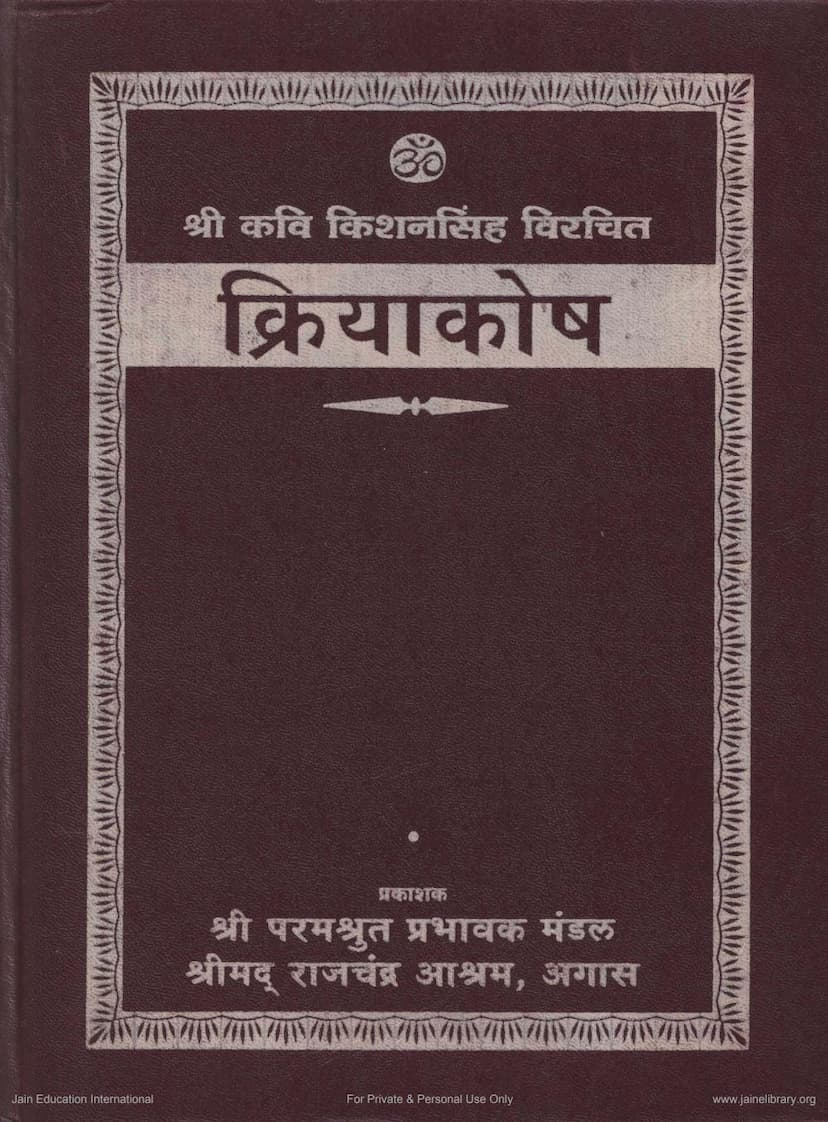Kriyakosha
Added to library: September 2, 2025

Summary
Here's a comprehensive summary of the Jain text "Kriyakosha" by Kishansinh Kavi, based on the provided pages:
Title: Kriyakosha (The Treasury of Actions) Author: Kishansinh Kavi Publisher: Shri Paramshrut Prabhavak Mandal, Shrimad Rajchandra Ashram, Agas Language: Originally in poetic Hindi (old), with a Hindi prose translation by Pt. Pannalal Jain Sahityacharya, M.A., Ph.D. Publication Year: Second Edition (2005 CE), First Edition (1985 CE) Catalog Link: https://jainqq.org/explore/001925/1
Overall Purpose: Kriyakosha is a significant Jain text that meticulously details the prescribed actions and conduct for lay followers (Shravakas) in Jainism. It serves as a comprehensive guide to the Shravakachar (conduct of a lay follower), outlining various rituals, vows, disciplines, and ethical principles essential for a virtuous life aimed at spiritual progress and ultimate liberation.
Key Themes and Content:
-
Mangledcharan (Invocation): The book begins with invocations to the Tirthankaras and the core tenets of Jainism, setting a spiritual tone.
-
The Trefan Kriya (Fifty-three Actions): The central theme of the Kriyakosha is the enumeration and detailed description of these fifty-three actions, which form the backbone of Shravakachar. These are broadly categorized as:
- Eight Moolgun (Essential Vows): These are fundamental vows that lay followers observe.
- Twelve Vrat (Vows): These include the five Anuvaratas (lesser vows) and seven Gunavratas/Shikshavratas (augmenting vows).
- Twelve Tap (Austerities): These are practices for spiritual purification and discipline.
- One Samabhav (Equanimity): Maintaining a balanced mental state.
- Eleven Pratimas (Stages of Observance): Progressive stages of spiritual discipline for lay followers.
- Four Daan (Charities): Practices of giving.
- One Jalgalan (Water Filtering): A specific ritual for purifying water.
- One Anasthmit Bhojan (Fasting before Sunset): A dietary discipline.
- Darshan, Gyan, Charitra (Right Faith, Right Knowledge, Right Conduct): The core principles of Jainism.
-
Detailed Descriptions of Actions: The text elaborates on each of the fifty-three actions, explaining their significance, the proper method of observance, and the associated benefits. This includes:
- Food and Drink Regulations: Detailed discussions on what is permissible and impermissible (twelve types of forbidden foods are mentioned), the proper preparation of food, rules regarding cooking utensils, and the importance of vigilance in daily consumption.
- Vows and Their Transgressions (Aticharas): The text explains each vow (like Ahimsa, Satya, Asteya, Brahmacharya, Aparigraha) and the specific actions that constitute their transgression.
- Austerities (Tapas): A detailed exposition of twelve types of external and internal austerities.
- Stages of Observance (Pratimas): The eleven stages of observance for Shravakas are explained, signifying a gradual progression in spiritual practice.
- Charities (Daan): The text describes four types of charity and emphasizes the importance of giving to worthy recipients.
- Rituals and Disciplines: Practices like water filtering (Jalgalan), timely eating (Anasthamita), observing purity in the kitchen, and meticulous attention to detail in all actions (Yatna).
- Prohibitions of False Beliefs and Practices: The book strongly condemns practices deviating from the true Jain path, discussing the origins and invalidity of various incorrect rituals and beliefs prevalent in society. This includes criticism of practices associated with superstitions, idol worship of non-Jain figures, and certain societal customs considered impure or leading to sin.
- The Importance of Purity and Vigilance: A recurring theme is the utmost importance of purity in actions, thoughts, and speech, especially concerning food, water, and personal conduct, to prevent harm to microscopic beings (Jivas) and to uphold the principles of Ahimsa.
-
Author's Life and Context: The introductory sections provide information about the author, Kishansinh Kavi, his background, the context of the work's publication, and references to Shrimad Rajchandra's appreciation of the text. It also mentions the sources and difficulties faced during the editing and translation process, highlighting the reliance on various manuscripts.
-
Inclusion of Stories and Examples: To illustrate the principles, the text often includes narratives and examples, sometimes drawing from historical or mythological Jain lore.
-
Structure and Language: The original text is poetic, and the translation aims to convey its meaning in accessible Hindi prose. The content is organized thematically, covering various aspects of Shravak life in detail, including specific rules for various situations, times of the year, and even dealing with the death rituals of relatives.
Significance:
- Practical Guide: Kriyakosha serves as a practical manual for Jain householders, offering clear guidelines for ethical living and spiritual discipline.
- Preservation of Tradition: It helps in preserving and disseminating the understanding of traditional Jain practices for lay followers.
- Emphasis on Action (Kriya): The title itself highlights the Jain emphasis on righteous action as a path to spiritual progress, complementing faith and knowledge.
- Theological Depth: By detailing these actions, the text implicitly underscores the Jain philosophy of karma, rebirth, and liberation, showing how mundane activities, when performed with right intention and discipline, contribute to spiritual merit.
In essence, "Kriyakosha" is a devotional and instructional work that offers a detailed roadmap for Jain laypeople to live a life of adherence to Jain principles, aiming for spiritual purity and eventual liberation. It meticulously covers the minutiae of daily conduct, reinforcing the Jain emphasis on conscious living and ethical practice.